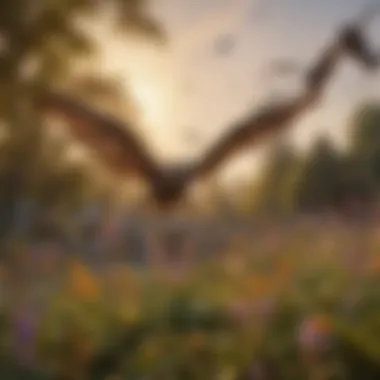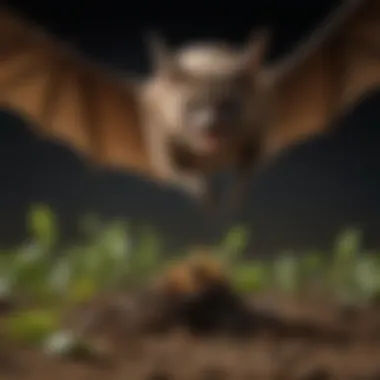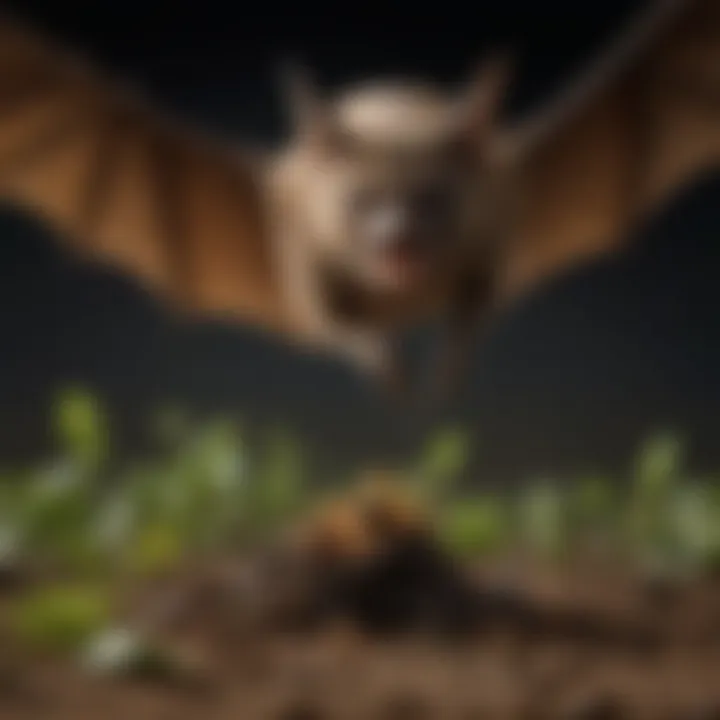The Importance of Bats in Garden Ecosystems


Intro
When one thinks of a garden, the immediate images may include sunflowers swaying in the breeze, vegetables reaching for the sky, or fluttering butterflies gracing the flowers. However, lurking in the shadows, specifically at dusk when the sun bids adieu, bats play an unseen yet crucial role. Their presence isn't just about the allure of the night; these fascinating creatures are fundamental to a healthy garden ecosystem. Engaging with bats enables gardeners to unearth layers of benefits that, while often overlooked, can transform a garden from ordinary to extraordinary.
Bats are more than mere aerial entertainers. In fact, they are nature’s pest control agents, tirelessly swooping through air to catch insects, with many species consuming thousands of bugs in a single night. This natural form of pest management can reduce reliance on chemical pesticides, which might harm beneficial insects, plants, and soil health. Moreover, the companionship of bats contributes positively to biodiversity, creating an symbiotic relationship between flora, fauna, and the eco-system at large.
In our journey to comprehend the significance of bats in gardens, we'll navigate through vital terms and concepts, historical perspectives, recent trends in sustainable practices, and practical techniques for cohabitation with these remarkable mammals. Let's dive into the primary ideas surrounding these nocturnal allies.
Preface to Bats
Bats often get a bad rap, but the truth is, they're super important in garden ecosystems. Understanding these unique creatures sets the stage for appreciating how they fit into our gardens. Not only do they provide critical pest control, but they also encourage biodiversity, promoting healthier growth in plants and a more balanced environment.
Let’s dig into the nitty-gritty about bats—both their biology and the species most commonly spotted in gardens. Getting familiar with them can help dispel myths and misunderstandings that often surround these nocturnal allies.
Understanding Bat Biology
Bats belong to the order Chiroptera, which means "hand-wing." They’re the only flying mammals and play a key role in various ecosystems. Unlike many other creatures, their echolocation capabilities allow them to navigate and hunt in complete darkness, making them remarkably efficient at catching insects.
Moreover, bats have diverse diets. While some feast solely on insects—think moths, beetles, and mosquitoes—others might nibble on fruit or nectar. This dietary variety is what makes bats so beneficial; by consuming vast amounts of pests, they act like nature’s pest control agents.
Also worth noting is that bats can live for quite a long time. Some species can reach ages of up to 30 years in the wild, which means they have ample opportunity to impact local ecosystems across multiple growing seasons. Thus, nurturing conditions that favor bats can reap long-term benefits for your garden.
Common Species Found in Gardens
There’s a whole cast of bat characters that call gardens their home. In many areas, you might encounter Brown bats, Little Brown bats, and even the Mexican free-tailed bats.
- Brown Bat (Eptesicus fuscus): A robust species commonly seen in urban areas, known for its adaptability to various environments, including gardens.
- Little Brown Bat (Myotis lucifugus): Once a common sight, this small mammal is experiencing population declines but is noted for its appetite for insect pests.
- Mexican Free-tailed Bat (Tadarida brasiliensis): Named for its distinctive tail, it’s famous for its high-speed dives while hunting, able to consume a hefty amount of insects in a single night.
Their habits may vary—some prefer open areas, while others are more inclined towards wooded regions. Habitat diversity in gardens can attract multiple bat species, enhancing both pest control and pollination.
All in all, educating ourselves about the traits and differences of these bats prepares us better to appreciate their roles and benefits in garden ecosystems. > "Bats are not just flying mice; they are guardians of the night, keeping pests in check while sowing the seeds of diversity."
In summary, by exploring bat biology and understanding common species, we open doors to a world where these misunderstood animals become valued partners in the gardening experience.
Bats and Ecosystem Health
Bats play a crucial role in maintaining the balance of garden ecosystems. Their impact extends beyond merely fluttering around at night; these remarkable mammals contribute significantly to pest control, pollination, and overall biodiversity. For anyone focused on cultivating a vibrant garden, understanding the benefits bats bring can truly enhance the gardening experience. The interdependence between bats and the flora they interact with leads to a dynamic that supports diverse plant life and improved garden health.
Pest Control Contributions
Types of Pests Consumed
Bats serve as nature's pest control agents, chomping down on a wide variety of insects that could otherwise wreak havoc in gardens. From moths and beetles to mosquitoes and flies, these creatures consume thousands of pests in a single night. What's significant here is that bats provide a level of pest management that is natural and sustainable. This characteristic makes them an exceptionally beneficial ally for gardeners looking to reduce reliance on chemical pesticides.
Among the many insects bats feast upon, moths are particularly notable. Not only do they thrive in warm months, but they also tend to be nocturnal, making them a perfect snack for bats. The unique ability of bats to locate these pests using echolocation showcases their adaptability and makes them a pivotal player in maintaining insect populations at manageable levels.
However, while bats are beneficial in controlling certain insects, it’s important to balance expectations. In exceptionally infested areas, bats alone may not suffice, suggesting that these creatures should be part of a more extensive pest management strategy.
Impact on Garden Health
The benefits of bats extend beyond just reducing pest populations; their presence can improve overall garden health. With fewer pests around, the plants can thrive without undue stress, potentially leading to bigger yields and healthier foliage. Not to mention, many pests are carriers of diseases that can directly affect plants—by controlling these populations, bats also reduce the risk of disease spread.
It’s also worth mentioning that bat droppings, or guano, can enrich the soil, serving as a natural fertilizer. Guano is packed with essential nutrients that can boost the vitality of garden beds. Nevertheless, an over-reliance on this alone can lead to nutrient imbalances, so it is wise to consider it as a supplement rather than a primary source of fertilization.


Pollination and Seed Dispersal
Plant Relationships
Surprisingly, bats also contribute to pollination in various plant species. While most folks might think of bees or butterflies when contemplating pollinators, certain bats play a vital role in facilitating pollination for plants like the agave. These bats have evolved to have long snouts and tongues, making them uniquely equipped to reach the nectar deep within flowers. In return, they help exchange pollen as they flit from bloom to bloom, underscoring a natural relationship that benefits both parties.
The relationship between bats and plants exemplifies mutualism, where both species benefit. This symbiotic interaction is not just confined to flowers; some plants even rely heavily on bats for seed dispersal, which is an essential process for maintaining diverse plant populations. The disadvantage here, however, is that not all gardens have bat-pollinated species, meaning the success of this relationship heavily depends on regional flora.
Benefits to Biodiversity
The relationship between bats and the garden ecosystem leads to increased biodiversity. The activities of bats support a variety of plant species, which in turn create habitats for other creatures. This web of life enhances the health of the garden. Diversity in plant life is crucial because it can lead to increased resilience against pests and diseases, promoting an overall sustainable environment.
Additionally, greater biodiversity attracts various beneficial insects and wildlife that contribute further to the ecosystem's stability. Yet, the challenge lies in maintaining a balance; too much emphasis on bat attraction can overshadow the needs of other species, which is why a holistic approach should be emphasized.
"Creating a balanced ecosystem in your garden is not just about attracting one beneficial species like bats; it's about developing a rich tapestry of life that supports and nurtures all its members."
Ultimately, an understanding of the roles bats and other wildlife play can guide gardeners toward creating a thriving ecosystem that honors the interconnections between all living things.
Creating a Bat-Friendly Garden
Creating a bat-friendly garden is not just an act of goodwill towards the wildlife in your vicinity; it significantly contributes to your garden's health and vitality. Bats play a crucial role in maintaining the ecosystem, and providing them with a welcoming environment can lead to a natural balance that benefits both plants and gardeners alike. By understanding the specific needs of bats, you can tailor your garden to attract these nighttime pollinators and pest controllers, thus fostering a vibrant ecosystem.
Habitat Requirements for Bats
Shelter
Shelter is fundamental for bats, as they seek safe spots to roost and reproduce. Ideal shelters mimic their natural habitats, which include caves, trees, and under eaves. For gardens, bat houses can be a practical alternative, offering a secure environment away from predators. A key characteristic of these bat houses is their design. They should be built with materials that provide insulation and protection and placed about 10 to 15 feet off the ground in a south or southeast direction. This makes it a beneficial choice, as it allows bats to warm up in the early morning sun.
However, it’s worth noting that not all bat houses are created equal. Improperly designed structures can actually deter bats. A unique feature of a well-constructed bat house is the incorporation of narrow crevices, allowing bats to cling securely while roosting. The downside is that if not monitored properly, bat houses can attract unwanted pests, necessitating regular checks for maintenance.
Food Sources
Food sources are crucial for attracting bats to your garden. These creatures primarily feed on insects, some of which can be garden pests themselves. A garden rich in variety—insects that bats consume—significantly boosts your chances of hosting these mammals. The key characteristic of food sources is their abundance. Healthy ecosystems promote a diverse range of insects, which then invites bats as natural pest controllers.
Uniquely, a healthy food web not only benefits bats but can also improve fruit yields. One downside is that a garden's ecological balance might sway if insect populations surge or decline too rapidly. However, by understanding this dynamic, gardeners can manage plant diversity to maintain stability.
Water Needs
Water is essential for the well-being of bats, much like it is for other wildlife. Gardens equipped with small water features or ponds can serve as drinking spots for these bats. A key characteristic of these water sources is that they must be easy to access and located in quieter areas to avoid disturbances. Adding a small pond or bird bath can notably increase the chances of bat visitation, especially in dry climates where natural water sources might become scarce.
However, the unique challenge often arises when maintaining clean water. Stagnant water can breed mosquitoes, which may inadvertently create a less inviting environment. Careful monitoring and regular cleaning of water features can mitigate such problems, ensuring bats continue to frequent your garden.
Incorporating Native Plants
Benefits of Native Flora
Native plants are integral for ecological stability in your garden. They are adapted to local soil, climate, and wildlife, making them resilient choices for gardening. The primary benefit of utilizing native flora is their ability to provide vital resources for local insect populations, which, in turn, draws bats into the area. These plants are typically perennial, requiring less maintenance and offering an array of benefits to the surrounding wildlife.
However, employing native plants has its unique challenges. Some may require specific soil types or exposure conditions that might not align directly with your existing garden layout. Adjustments can sometimes be necessary, but the end result is a landscape that thrives naturally.
Attracting Bats Through Plant Choice
Selecting the right plant species can be a powerful tool for attracting bats to your garden. Many bats pollinate plants while they feed, promoting biodiversity. The focus should be on night-blooming flowers such as moonflowers and evening primrose, which open after dusk, releasing enticing scents to lure bats. These plants hold a special ability to attract not only bats but also other beneficial nocturnal pollinators, amplifying your garden's ecosystem.
While this approach to attracting bats is appealing, it also brings some level of unpredictability. Planting a diverse range can lead to varying success in attracting specific bat species. Furthermore, garden space may become limited as your plant choices diversify. Balancing bat-friendly flora with the overall aesthetic of your garden is key, ensuring harmony in ecological value and visual appeal.


"A bat-friendly garden not only helps the bats but enriches our connection with nature and promotes sustainable practices in our own backyards."
Through intentional design and commitment to ecological balance, integrating bats into your gardening practices can foster a healthier, more vibrant ecosystem.
Managing Bat Interactions
In the gardening world, bats are often overlooked companions, beneficial creatures that play significant roles. Understanding how to manage bat interactions is essential for fostering a harmonious environment where both gardeners and bats can thrive. This involves addressing common concerns, myths, and practical strategies to ensure that bats remain a healthy part of your garden ecosystem.
Challenges may arise when dealing with bats, as misinformation can lead to unnecessary fear. By educating oneself about these animals and implementing best practices, gardeners can not only coexist with bats but also enhance the diversity of their gardens.
Preventing Misdirected Concerns
Myths About Bats
It’s a real head-scratcher how many myths swirl around bats. Many believe these creatures are bloodthirsty fiends lurking in the shadows. In truth, most bats are harmless and play vital roles in our ecosystems. For instance, the common misconception that all bats carry rabies is misleading. In reality, only a small percentage do, and transmission is exceedingly rare.
The key characteristic of these myths is how they heighten fear and misunderstanding. This is particularly detrimental for gardens, as it might push gardeners away from appreciating bats' contributions. By dispelling these myths, we can foster a more welcoming attitude toward these flying mammals.
A unique aspect of confronting these myths is that awareness itself can be an antidote. Education leads to understanding, resulting in a more balanced perspective on bats and their behavior—in turn, encouraging a positive coexistence.
Real Threats and Misunderstandings
When addressing the real threats surrounding bats, it's crucial to differentiate between legitimate concerns and exaggerated fears. Bats primarily feed on insects, substantially aiding in pest control. However, misinterpretations often arise about their presence in gardens. Some assume that any bat visit equals damage or infestation. This is far from reality; with appropriate management, bats can be appreciated allies rather than alarming pests.
The significant aspect of understanding these threats lies in identifying actual issues. For example, while some species may carry diseases, the risk to humans is minimal when compared to the benefits they provide. Guardians need to recognize the signs of a healthy bat population and maintain vigilance without allowing paranoia to dictate gardening choices.
Best Practices for Gardeners
Monitoring Bat Activity
Keeping tabs on bat activity is a prudent step for any gardener looking to embrace these creatures. Regular observation—especially during dusk when bats are most active—can reveal a lot about your local bat population. This not only helps in understanding their habits but also provides insight into the effectiveness of pest control in your garden.
The key feature of monitoring is that it can help you gauge which plants attract bats, further tailoring your garden to support its flying inhabitants. Moreover, this knowledge can bolster bat-friendly practices, allowing direct observation of their contributions and any areas needing enhancement.
Mitigating Potential Issues
In an ideal world, all interactions between bats and gardeners would be seamless. However, there may be potential issues that can arise. This section tackles how to mitigate disruptions while encouraging bat presence. Simple actions like installing bat houses can offer sanctuary for bats while keeping garden structures safe from unwanted encounters.
The unique feature of this practice is that it fosters a sense of stewardship. Gardeners who take the initiative to create safe environments for bats not only benefit their gardens but also promote ecological well-being. This leads to a garden that not only flourishes but contributes to a broader understanding of biodiversity.
"Bats are more than just flying mammals; they embody the delicate balance of nature, ensuring our gardens thrive amid the chaos of pests."
The Importance of Biodiversity
Biodiversity, the variety of life in a given ecosystem, plays a critical role in maintaining the health and balance of that ecosystem. In gardens, an array of species ranging from plants to animals fosters a harmonious environment that benefits all inhabitants. Bats, often overlooked yet pivotal, contribute significantly to this diversity and its benefits. Understanding their role provides insights into why biodiversity matters, especially in gardening contexts.
Bats as Indicator Species
Bats are often referred to as indicator species because their presence or absence can reflect the health of an ecosystem. When bat populations thrive, it generally signals a well-balanced habitat rich in resources like food and shelter. Conversely, dwindling bat numbers can indicate environmental stresses—perhaps due to habitat loss or pesticide use.
Their diet, primarily composed of insects, makes bats excellent monitors for insect population health. If bats are flourishing, it's likely that the insect prey they depend on is also abundant and stable, indicating a balanced ecosystem.
"The decline of bat populations can serve as a warning bell, alerting us to broader ecological issues one might not initially see."


Therefore, gardeners who observe healthy bat populations are witnessing firsthand the vitality of their garden's ecosystem. Such gardens are better equipped to handle pests naturally, reducing dependency on chemical controls that may further harm biodiversity.
Encouraging a Diverse Ecosystem
Encouraging biodiversity in gardens goes beyond merely housing various species. It’s about creating a web of interactions that benefit every organism involved. For gardeners, promoting diversity not only aids in pest control, but also enhances pollination and seed dispersal, effectively creating an ecosystem that supports healthier plants.
Some steps to promote ecosystem diversity might include:
- Planting Native Species: Native plants are better adapted to local conditions. This attracts local wildlife, including bats, which find food and shelter more easily.
- Creating Water Sources: A small pond or water feature can be a magnet for various wildlife, aiding in biodiversity.
- Employing Companion Planting: Certain plants can enhance the growth of others while repelling pests that bats target.
This rich diversity brings resilience against pests and diseases, making gardens more robust and adaptable to environmental changes.
Integrating bats into this larger picture of biodiversity enhances the overall productivity of gardens, ensuring they can thrive even in challenging conditions. Each species, including bats, plays a part—missing one can shift the entire balance.
By understanding the intertwined roles of species within garden ecosystems, gardeners can foster an environment where both flora and fauna flourish, ultimately benefiting from the interconnected dance of life that characterizes a healthy ecosystem.
Case Studies of Successful Integration
The integration of bats into garden ecosystems presents an invaluable opportunity for gardeners and agricultural enthusiasts alike. These nocturnal creatures contribute significantly to pest control and enhance the biodiversity of the environment. This section emphasizes real-world examples where communities and researchers have successfully blended agricultural practices with bat preservation. Understanding these case studies not only illuminates potential benefits but also provides a blueprint for enhancing garden health while advocating for wildlife conservation.
Community Gardens and Bats
Community gardens have emerged as beneficial havens for both local flora and fauna. A prime example is the case of a community garden in Portland, Oregon. Here, residents took the initiative to attract bats by installing bat houses around the perimeter of their garden. This effort wasn't just about creating a pretty sight or an appealing structure. A group of engaged volunteers observed a marked decrease in insect populations – particularly moths and beetles – which had previously plagued their crops.
In community gardening, the impact of bats can be multifaceted:
- Pest Control: With bats feeding on these pests, gardeners reported healthier plants and higher yields. Instead of relying solely on chemical pesticides, they embraced a more harmonious approach.
- Educational Workshops: This Portland garden also hosted workshops to educate community members about bat behaviors and their ecological roles. This helped dispel common myths and fostered a culture of respect and understanding toward these animals.
- Community Engagement: The initiative promoted collaboration among residents, as everyone contributed to building and maintaining bat houses. This not only strengthened community ties but also reinforced the notion that local actions can have significant environmental impacts.
Research Findings on Bats in Agricultural Systems
Numerous research studies have begun to shine a light on the statistical benefits of bats in agricultural settings. One notable study conducted at agricultural sites in Texas examined the relationship between bat activity and crop yield. Researchers found that fields situated near natural bat habitats yielded almost 20% more produce than those situated further away.
Key findings from this study included:
- Diverse Diet: Bats consume a wide variety of pests, including beetles, caterpillars, and other insects harmful to crops, highlighting their role as natural pest deterrents.
- Foraging Patterns: Bats exhibited specific foraging patterns that suggest they effectively cover vast areas. This behavior allows them to significantly reduce pest populations over a broader range, reinforcing their value in an agricultural context.
- Ecosystem Resilience: The research illustrated that integrating bats into farming practices leads to more resilient ecosystems. Healthier ecosystems not only support bat populations but also contribute to sustainable agricultural practices by reducing the need for chemical interventions.
Bat-friendly practices are gaining momentum in both urban community gardens and expansive agricultural systems, enabling a coexistence that underscores biodiversity while enhancing garden productivity.
A thriving garden can be a testament to the beauty of coexistence, where plants, pests, and bats work together in an intricate dance of survival and support.
By examining these case studies, it becomes increasingly apparent that embracing bats may well be a key strategy for sustainable gardening and agriculture, benefiting both plants and humans in the process.
Finale and Future Directions
As we wrap our discussion on bats and their roles in garden ecosystems, it's essential to reflect on their remarkable contributions and the pressing need for their protection. Bats offer more than just a whimsical sight at dusk; they are powerful allies in maintaining balance in our gardens. Understanding their multifaceted role can guide us toward sustainable practices that not only promote a thriving garden but also guard against the decline of these vital creatures.
Summary of Bats' Impact
Bats serve as small, but mighty guardians of our gardens. Their presence significantly alters the dynamics within these ecosystems. Consider the following points in summarizing their impact:
- Pest Control: A single bat can consume upwards of a thousand insects in an hour. That’s a staggering amount of pest control achieved purely through their nightly foraging.
- Pollination: Certain bat species play a crucial role in pollinating plants, particularly in tropical regions. This not only enhances plant diversity but supports the broader ecosystem, which benefits all gardeners.
- Soil Health: Through their droppings, or guano, bats contribute nutrients to the soil, helping plants grow healthier and stronger. Thus, their impact stretches beyond mere insect consumption.
"Bats are nature’s pest control experts, silently working their magic while we sleep."
Advocating for Bat Protection
With the wealth of benefits that bats bring, it's equally important to focus on their conservation. Here are some key considerations on advocating for their protection:
- Habitat Preservation: Advocating for the conservation of natural habitats is crucial. Urbanization and habitat destruction are significant threats to bat populations.
- Community Awareness: Educating the community about the benefits of bats can lead to more positive perceptions and protective actions. Initiatives can be established in schools and local communities to highlight the importance of bats.
- Legislation: Supporting policies that protect bats and their habitats can lead to meaningful change. This includes advocating for the preservation of old trees and caves that serve as roosting sites.
- Encouraging Backyard Habitats: By creating bat-friendly environments in our own gardens, we contribute to their survival. Installing bat boxes and planting native flora can offer safe havens for these nocturnal beings.
In closing, as we navigate into the future, we must carry the torch for bats. Every action counts, and by recognizing and promoting their vital place in our gardens, we pave the way for a thriving ecosystem that benefits us all.















